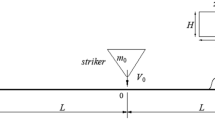Abstract
Experimental investigations were performed in order to verify the maximum impact force and the time function of the central deflection which were derived by a simplified theory. This theory is only applicable in the short time interval after contact when the stresses in the vicinity of the contact point are only a function of the interaction between the colliding bodies. It will be assumed that the reflected elastic waves have no influence on these stresses. The maximum impact force can be expected to occur in this time interval.
Similar content being viewed by others
Abbreviations
- m :
-
mass of the striking ball (=885 g or 1.951 1b)
- r :
-
radius of the ball (=3 cm or 1.181 in.)
- ρ:
-
density of the beam and ball (=7.75 g/cm3 or 27.99×10−2 lb/in.3)
- L :
-
length of the beam (=86 cm or 33.86 in.)
- h :
-
height of the beam (=5.074 cm or 1.998 in.)
- d :
-
thickness of the beam (=2.535 cm or 0.998 in.)
- I :
-
moment of inertia (=1/12dh 3=27.59 cm4=0.663 in.4)
- x :
-
coordinate coincident with the neutral axis of the beam
- W 0 :
-
central deflection of the beam
- t, t′ :
-
time variables
- τ, τ′:
-
dimensionless time variables (t/T ort′/T)
- T :
-
reference time
- K :
-
Hertz constant (here,\(K = {\raise0.5ex\hbox{$\scriptstyle 2$}\kern-0.1em/\kern-0.15em\lower0.25ex\hbox{$\scriptstyle 3$}}\frac{E}{{(1 - v^2 )}}r^{{\raise0.5ex\hbox{$\scriptstyle 1$}\kern-0.1em/\kern-0.15em\lower0.25ex\hbox{$\scriptstyle 2$}}}\))
- \(\varepsilon _{45}\) :
-
strain under 45 deg to the beam axis
- v 0 :
-
impact velocity
- \(\omega _n\) :
-
Eigenfrequency\(\left( { = \frac{{n^2 \pi ^2 }}{{L^2 }}\left( {\frac{{EI}}{{d\rho h}}} \right)^{{\raise0.7ex\hbox{$1$} \!\mathord{\left/ {\vphantom {1 2}}\right.\kern-\nulldelimiterspace}\!\lower0.7ex\hbox{$2$}}} } \right)\)
- P :
-
impact force
- \(\sigma ^{{\raise0.7ex\hbox{$3$} \!\mathord{\left/ {\vphantom {3 2}}\right.\kern-\nulldelimiterspace}\!\lower0.7ex\hbox{$2$}}}\) :
-
dimensionless impact force
- n :
-
ordinal number of flexural vibration (=1, 2, 3, ...)
- E :
-
Young’s modulus of the beam and ball, respectively (=2.10×106 kp/cm2=29.87×106 lb/in.2)
- ν:
-
Poisson’s ratio of the beam and ball (=0.28)
- α:
-
beam parameter
- λ:
-
impact parameter
References
Schwieger, H., “Die maximale mechanische Beanspruchung beim zentralen Balkenquerstoss”,ZAMM 45,Nr. 7/8,499–506 (1965).
Schwieger, H., “A Simple Calculation of the Transverse Impact on Beams and its Experimental Verification,” Second Internatl. Congress on Experimental Mechanics, Washington, D. C. (Sept. 28–Oct. 1, 1965).
Schmidt, B., “Kontaktkraft und Biegespannungen im quergestossenen Balken,” Technische Hochschule Darmstadt, Dissertation (April 1966).
Schwieger, H., and Reimann, V., “Spannungsoptische Untersuchung des Balkenquerstosses,” IX Internatl. Congress on Applied Mechanics, Brussels, Belgium (Sept. 5–Sept. 13, 1956).
Author information
Authors and Affiliations
Additional information
He is now associated with
Rights and permissions
About this article
Cite this article
Schwieger, H. Central deflection of a transversely struck beam. Experimental Mechanics 10, 166–169 (1970). https://doi.org/10.1007/BF02324974
Issue Date:
DOI: https://doi.org/10.1007/BF02324974



